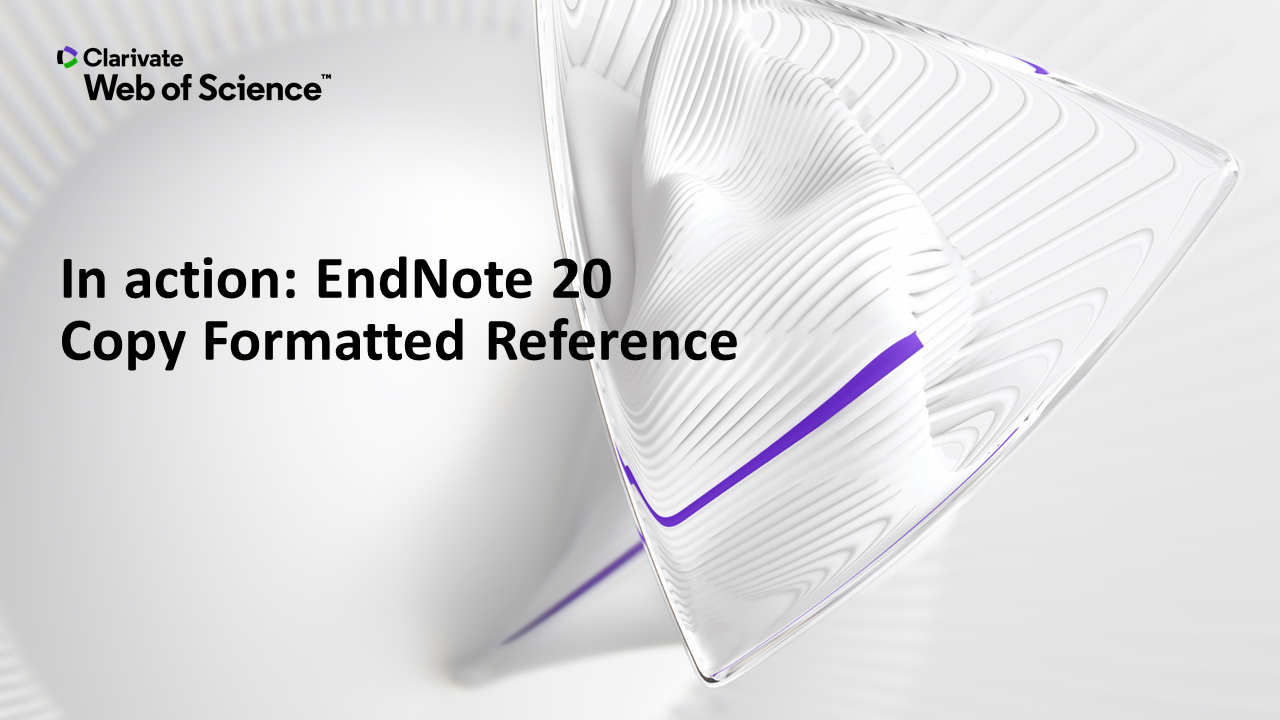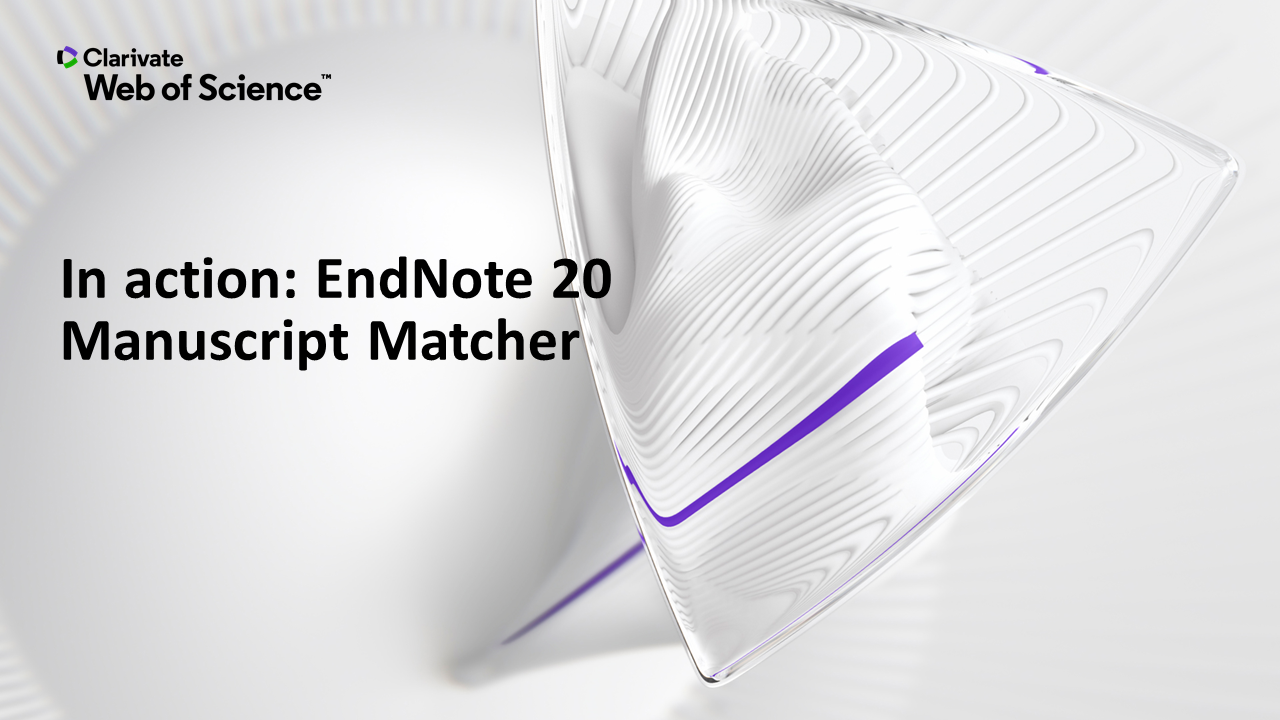You may be required to adopt a specific citation style when you are preparing an assignment or when submitting a manuscript to a journal. There are more than 500 citation styles pre-installed in EndNote for your selection:
|
|
|
|
|
You can learn more about selecting an output style and getting additional styles from the official video below (starting from 12:14 to 13:29):
If you still cannot find the style you need, try to download it from EndNote Output Styles, where you can find more than 6000 styles including those from publishers, journals, etc.
|
|
|
|
|
|
|
|
|
|
|
|
|
|
|
|
|
|
By default, the downloaded citation style will be saved in Documents > EndNote > Styles.
Sometimes the styles EndNote provides may not exactly meet your needs. You may need to modify the style to fit into the requirement. EndNote is well known for its highly customizable citation styles. To edit or customize a citation style, you can refer to the tips below.
|
|
|
|
|
|
|
Identify the area(s) you would like to edit from the sidebar. Below are some examples.
Edit the style according to your needs, e.g. to remove DOI for journal articles. In this case, you will need to edit the Templates under Bibliography.

|
|
In the case below, Ed. will be shown if there is only one editor, and Eds. will be shown if there are multiple editors. |
|
|
In the case below, ed. will be shown only when the Edition information in the reference record is not empty. |
|
|
In the case below, all the Edition, ed., Vol. and Volume will show together or disappear together if there is no forced separation (vertical bar |) between them. |
|
|
In the case below, both the word "doi:" and DOI field will be shown if "doi:" is put within a pair of back quotes. |
|
|
To save an edited citation style, follow Steps 5 - 10 in Get More Citation Styles.
|
|
|
|
|
|
|
|
|
|
By default, the downloaded citation style will be saved in Documents > EndNote > Styles.
You may seek our help via the Research Consultation Appointment Form if you wish us to work with you in editing the citation style.
Sometimes, you may need a copy of your reference list in the Word document for backup or sharing purpose. In this case you may follow the steps below:
|
|
|
|
|
|
|
Note that references created from "Copy Formatted" are in plain text format.
Refer to Insert In-text Citations and Create Bibliographies to learn how to create both in-text citations and bibliographies.
You can learn more about creating an independent bibliography from the official video below, which share the same steps as EndNote 2025:
 |
The "Find Full Text" feature allows EndNote users to download some full-text articles from references saved in your EndNote Library. However, it is important to note that this function is subject to limitations imposed by the University's subscription and other technical issues:
• Only some (but not all) Library subscribed publications would have PDFs downloaded via EndNote’s “Find Full Text”.
• The ability to retrieve PDFs from “Find Full Text” could be varied among different databases.. It is really depending on the compatibility of individual content providers. As stated on a Clarivate’s EndNote FAQ, “Find Full Text” feature is not compatible with EBSCO, JSTOR, Wiley and ScienceDirect. To learn more about the compatibility issues of different databases, please refer to EndNote’s official websites for the latest information.
• By using “Find Full Text”, users may initiate prohibited, excessive or systematic downloads which may result in a university-wide suspension to affected databases.. Therefore, do use this function with care and only download the full text of the article you intend to read.
To use the Find Full Text function, you need to first change a few settings in your EndNote, with the steps below:
|
|
|
|
|
|
*NOTE: The ability to retrieve full text from find full-text function may vary, depending on the compatibility of individual content providers. According to Clarivate’s EndNote FAQ, it has been noted that some providers such as EBSCO, JSTOR, OpenAthns, Wiley, and ScienceDirect do not support this feature. Due to security features implemented by these providers, EndNote is not able to download and attach the PDF automatically, however, it may be able to add a URL to the library reference. If so, this link may bring you to a page where you can download the PDF manually to attach to your library.
After configuring the settings for Find Full Text, you can use the Find Full Text feature with the following steps:
|
|
|
|
|
|
|
You can learn more about performing a Find Full Text search from the official video below (starting from 8:29 to 11:02):
*NOTE: The ability to retrieve full text from find full-text function may vary, depending on the compatibility of individual content providers. According to Clarivate’s EndNote FAQ, it has been noted that some providers such as EBSCO, JSTOR, OpenAthns, Wiley, and ScienceDirect do not support this feature. Due to security features implemented by these providers, EndNote is not able to download and attach the PDF automatically, however, it may be able to add a URL to the library reference. If so, this link may bring you to a page where you can download the PDF manually to attach to your library.
*Note: This function has been replaced by “Find a Journal” in the latest release of EndNote 2025 (Microsoft Word Online and Google Docs with Cite White You Write (CWYW) plugin). For EndNote 20 and 21 users, you may refer to the instructions below on using Manuscript Matcher.
Manuscript Matcher can help you find the best fit journals for publishing based on 1) the title and abstract of your manuscript, and 2) the references in your EndNote library or a Word document. The source data is from Web of Science, so most of the suggested journals will have an Impact Factor.
|
|
|
|
|
|
|
|
|
|
|
|
|
|
You can learn more about using Manuscript Matcher via Cite While You Write from the official video for EndNote 20, which share the same steps as EndNote 21 below:
 |
This makes use of the Citation Report function in Web of Science. You can get a citation report from WOS for a group of references in your EndNote library if they are imported from Web of Science:
|
|
|
|
|
|
|
You will be able to see the citation numbers in Web of Science for the selected references. |
|
|
You can learn more about creating citation reports from the official video below, which share the same steps as EndNote 2025 below:
 |
Most LaTeX users use JabRef, another reference management tool to handle references and citations in LaTeX environment. However, if you have created your reference list in EndNote and now need to prepare your paper using LaTeX, you can transfer your references from EndNote to JabRef by exporting them in BibTeX format:
|
|
|
|
|
|
|
|
|
|
|
For more information, you may refer to this video tutorial Export references from EndNote to BibTex to use them in LaTeX or this guide using EndNote with LaTeX and BibTeX.
You can export and save your references in XML format and then import it to Mendeley or Zotero. If you have created groups in your EndNote library, we advise you to export your references group by group so that you don't lose your groupings when exporting to Mendeley or Zotero.
|
|
|
|
|
|
|
|
You can import references into Mendeley with the steps below:
|
|
|
|
|
|
You can import references into Zotero with the steps below:
|
|
|
|
|
|
|
EndNote only provides mobile apps for iOS. For the basic features, please refer to the official guide.
For in-text citation, EndNote for iOS only allows inserting temporary citation in a Word document. You still need to complete the in-text citation and bibliography by Cite-While-You-Write in MS Word installed via EndNote desktop or EndNote Web. You may refer to this FAQ for more details.